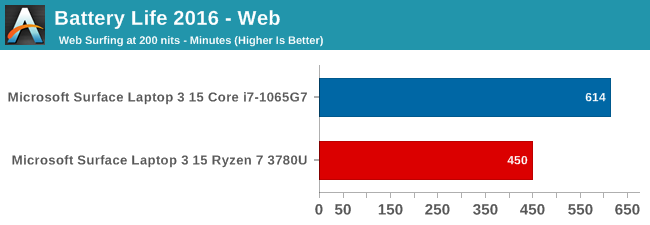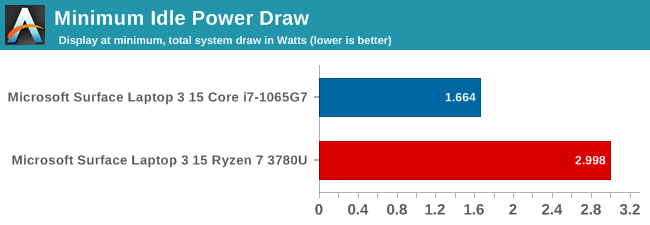The Microsoft Surface Laptop 3 Showdown: AMD's Ryzen Picasso vs. Intel's Ice Lake
by Brett Howse & Andrei Frumusanu on December 13, 2019 8:30 AM ESTPlatform Power
Performance aside, the other side of the coin is battery life. AMD made big gains in battery life with the Ryzen 3000 series, somewhat addressing the power requirements of the platform and getting rid of some of the excessive idle power draw, but they are still using DDR4 on their mobile platform, which puts them at a disadvantage right out of the gate. Intel has made very good gains in battery life over the last several generations, and the move to 10 nm for Ice Lake also brought along LPDDR4X support. Most of the previous generation laptops stuck with LPDDR3, unless the manufacturer needed more than 16 GB of RAM, where they’d be forced to switch to DDR4. Finally adding LPDDR4X support is something that Intel has needed to do for a while, and ironically Intel’s flagship Core product line lagged behind their low-cost Atom lineup which did support LPDDR4.
Web Battery Life

The Ryzen 7 3780U powered Surface Laptop 3 was slightly under the Ryzen 5 device we tested at launch, but still in the same range. The AMD system isn’t helped very much by Microsoft only offering a 46 Wh nominal battery capacity, which is rather undersized for a 15-inch laptop. The Ice Lake device, as we’ve seen before, was much more efficient under load, offering a sizeable battery life lead.
Idle Power
One of AMD’s biggest challenges was to get their laptop SoC into a premium device, and with the Surface Laptop 3 they have succeeded. Microsoft has shown themselves as being adept at squeezing battery life out of devices, with low-power displays, and good internal components to minimize power draw. Here Intel has held a considerable advantage over the last couple of years, and the move to 10 nm should, in theory, help as well.
To test the idle power draw of both systems, the battery discharge rate was monitored with the screens fixed in at 5.35 nits, to minimize the power draw of the display on the result. Normally we’d prefer to have the display completely off for this test, but Microsoft’s power plan on the Surface Laptop actively turns off the laptop when the display times out.

The Ice Lake system was able to go all the way down to right around 2 Watts of power draw – and sometimes slightly under – with as low as 1.7 Watts seen. We’ve seen under 1 Watt of draw on an 8th generation Core Y series processor, and around 1.5 Watts on the same generation U series, so considering the display is not completely off on the Surface Laptop, the 2-Watt draw is quite reasonable.
The Picasso system was not quite as efficient, drawing 3 Watts at idle. This is in-line with the results we’ve seen on other Picasso systems and explains the lower battery life results on the AMD system. AMD made big gains moving from Raven Ridge to Picasso, but I’m sure the team is looking forward to the 7 nm Zen 2 coming to their laptops, which we hope will address this further.










174 Comments
View All Comments
serendip - Saturday, December 14, 2019 - link
The pricing borders on the ridiculous for the AMD version of the SL3, on top of the Ice Lake variant not being available for consumers. I'm all for competition in the mobile chip arena but Ryzen Picasso is uncompetitive at $2000. Microsoft really made a mess this time. But then again, the 15" SL3 is a niche of a niche product, so they could be using this as an experiment for AMD on the next Surface Pro.MBarton - Monday, December 30, 2019 - link
The only reason Microsoft is using leftover Zen Picasso parts is because Intel's 10nm is so pathetic that they can't get enough working Intel parts to supply demand. So Microsoft got a cheap deal on old Zen+ parts to help fill the void. Low margin mobile CPU markets are not what AMD is focused on. AMD needs money and the profits are in the server market and HEDT market.Jhlot - Sunday, December 15, 2019 - link
"On purely CPU based tasks, Ice Lake really stretched its legs, and despite this being a 3.9 GHz chip, in single-threaded SPEC 2017, it managed to come very close to a 5.0 GHz Core i9-9900K with a massively higher TDP.Sunny Cove cores on Desktop are going to very good if Intel can get the darn things out.
eastcoast_pete - Sunday, December 15, 2019 - link
Maybe somebody at AT or here knows, but my favorite suspicion why MS even had a Ryzen mobile system on offer despite it being a full generation behind is that they didn't trust Intel getting their 10 nm Ice Lake fabbing straightened out in time, and didn't want to risk getting caught without pants. In other words, was this MS playing it safe with the AMD APU as second option just in case Intel came up short again? What's the word?heffeque - Sunday, December 15, 2019 - link
This sounds very plausible.MBarton - Monday, December 30, 2019 - link
Intel HASN'T gotten their 10nm Ice Lake "straightened out". Hence why Intel is suddenly mum on Ice Lake server parts. They've totally disappeared from presentations. Why anybody thought that Intel would get ICL "straightened out" now, out of the blue, is beyond me. 10nm is essentially dead.AntonErtl - Sunday, December 15, 2019 - link
As long as the Ryzen U chips don't get competetive idle power consumption, they will have a severe handicap in the laptop market. But for small fanless barebones systems (e.g., something like the Zotac ZBOX CI series), they should be quite appropriate. I wonder why we don't see them in that capacity.Farfolomew - Sunday, December 15, 2019 - link
10th Gen Comet Lake CPUs are better than Ryzen 3k APUs. Of course Ice Lake is going to dominate. Zen 3 better be decent to compete with Icelake on desktop.scineram - Monday, December 16, 2019 - link
What Icelake on desktop?maroon1 - Tuesday, December 17, 2019 - link
We won't see icelake on desktop even next year